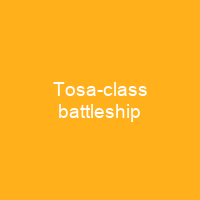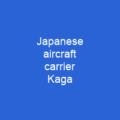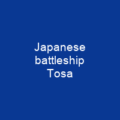The Tosa-Class Battleships: A Tale of Triumph and Tragedy
Imagine a world where the largest warships ever built were not just symbols of power but also vessels of destiny, carrying the hopes and fears of an entire nation. The Tosa-class battleships, two mighty dreadnoughts ordered by Japan in the early 1920s, stand as a testament to this era of naval supremacy. These ships were part of the ‘Eight-Eight’ fleet, designed to be larger and more powerful than anything seen before.
From Dreams to Reality
The first ship in the class, Tosa, was a marvel of engineering, with an overall length of 234.09 meters and a beam of 30.48 meters. Its metacentric height was 1.292 meters, and it could reach speeds of 26.5 knots. However, the dream of these mighty ships was cut short by the Washington Naval Treaty in 1922. The treaty aimed to limit naval armaments among the major powers, and Tosa became a casualty of this agreement.
The Fate of Tosa
Stricken from service in 1924, what happened next with Tosa? Some of its guns were repurposed as coastal artillery, while others met their end through scrapping. The incomplete hull was used for experiments to improve armor-piercing shells, and the ship was eventually scuttled in 1925 due to a failed demolition attempt. It’s a poignant reminder that even the mightiest of ships can fall victim to political decisions.
The Transformation of Kaga
While Tosa met its end, another ship in the class, Kaga, had a more dramatic journey. Originally slated for scrapping, it was converted into an aircraft carrier instead. This transformation marked the beginning of a new era in naval warfare, where air power began to overshadow traditional battleship dominance.
A Carrier’s Journey
After undergoing several reconstructions, including the removal of lower decks and the addition of heavier aircraft capacity, Kaga became a formidable force. It supported Japanese troops in China during the Second Sino-Japanese War and took part in the infamous attack on Pearl Harbor. Its role as an aircraft carrier made it more vulnerable but also more crucial to Japan’s war efforts.
The Fall of Kaga
However, Kaga‘s journey came to a tragic end during the Battle of Midway in 1942. Sunk by aircraft from USS Enterprise, Hornet, and Yorktown on June 4, 1942, it was a turning point that marked the decline of Japanese naval power. The loss of Kaga symbolized not just the end of an era but also the changing nature of warfare in the Pacific.
Lessons from the Past
The story of the Tosa-class battleships is a reminder that even the most advanced technology can be rendered obsolete by political and strategic decisions. It’s a tale of transformation, resilience, and ultimately, tragedy. As we look back at these ships, we are left with questions about the future of naval warfare and the balance between tradition and innovation.
The Tosa-class battleships were more than just vessels; they were symbols of an era where dreams of maritime dominance clashed with the realities of international politics. Their legacy lives on in the annals of history, serving as a reminder that even the mightiest of ships can face their own trials and tribulations.
You want to know more about Tosa-class battleship?
This page is based on the article Tosa-class battleship published in Wikipedia (retrieved on November 28, 2024) and was automatically summarized using artificial intelligence.








